Arrangement of puja items used in puja vidhi is based on the level of the Panchatattvas (Five Cosmic Principles). It demonstrates the journey of the individual from Maya (The Great Illusion) to the Brahmatattva that is associated with the Panchatattvas starting from the Pruthvitattva to Akashtattva. This article gives analyses from the spiritual perspective, how and why by arranging the puja items in a specific way before puja, we derive benefit of the Divine Principle.
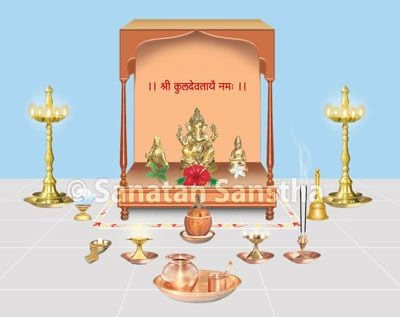
Levels of arrangement of puja items (substances and implements) used in puja (from bottom upwards, towards the temple at home)
1. First level – Naivedya and Puja thali
Implements associated with Pruthvitattva & Apatattva
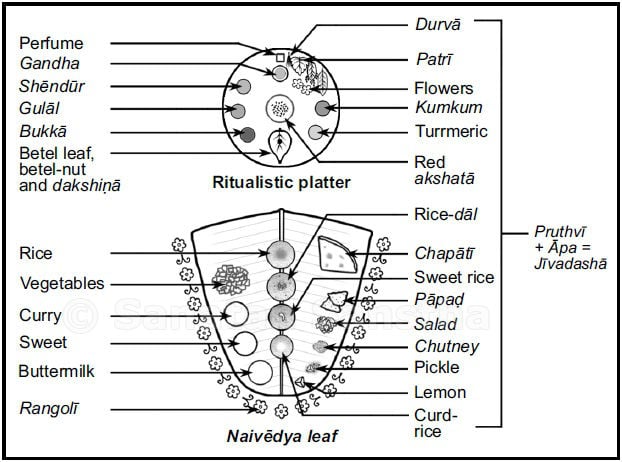
A. Banana leaf used for offering Naivedya
This signifies the actual gross state of the individual. Offering Naivedya is the last step in puja. The (Naivedya carrying) leaf is placed facing downward. Offering Naivedya helps please the superior Deities, Deity of the premises and Deity of the place in shorter time. In the actual arrangement do not place the Naivedya leaf. Offer Naivedya only after puja has been completed.
B. The puja thali (platter) used in the worship
Place the puja thali (platter) in front of the Idol of the Deity of worship.
-
In the puja thali, place haldi and kumkum to the right and bukka, gulal and shendur to the left of the individual.
-
Place a perfume bottle, sandalwood paste, flowers, durva and patri towards the Deity; fragrance particles in the perfume, sandalwood paste and flowers, colour particles in durva and patri activate the subtle-waves of the Deity.
-
In the platter, towards yourself, place a betel-nut and betel leaves and offering of money. Betel-nut and betel leaves are effective mediums to emit Divine waves.
-
In the middle of the puja thali (platter) place all-encompassing akshata. Since these are in the centre, they attract waves of the five superior Deities – Shiva, Shri Durgadevi, Shriram, Shrikrushna and Shri Ganapati, and get emitted towards the surrounding puja items like haldi (Turmeric), kumkum (Vermilion) etc. as per the need.
2. The second level – A kalash, a tumbler and a ritualistic spoon
Implements associated with Apatattva
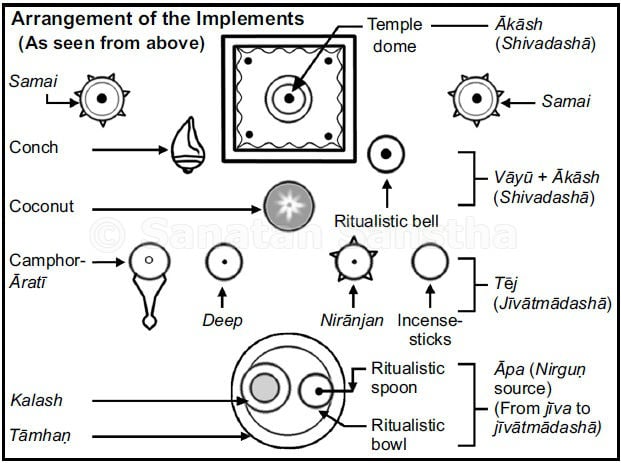
Place these puja items in the centre. Water being pure, it is able to absorb nirgun waves of Deity the most. This is referred to as ‘the central channel in sagun ̣of the arrangement of implements, that is, Sushumnanadi; for, water in the kalash maintains appropriate balance of Panchatattvas. Place the platter in the centre and in it to the left of the individual, place the kalash (the functional Energy of the Deity) & to the right, place puja items like the tumbler, ritualistic spoon that are used in the rituals.
3. The Third Level
Implements associated with Tejtattva
-
Niranjan and incense-sticks : Place them to the right of the individual.
-
The ghee lamp : Place to the left of the individual.
-
The camphor Arati : Place it next to the ghee lamp. The marak fragrance waves emitted by the camphor purify the atmosphere. Hence, the camphor Arati is placed to the left of the individual, that is, to the right side of the Deity.
-
The coconut : Place the coconut in the centre in close proximity to the Deity. By placing the coconut with its tuft facing upwards, Divine waves from the universe activated by the worship are attracted to it and are emitted into the atmosphere like a fountain, thus purifying it.
4. The fourth level – Conch and Bell
Implements associated with Vayutattva (Absolute Air Principle) & Akashtattva
-
The conch : Place the conch to the left of the individual.
-
The bell : Place the bell to the right of the individual.
5. The fifth level – Samai
Implements associated with Tejtattva & Akashtattva
Place two samais of equal height, one on each side of the Devghar (temple at home). Preferably use sesame-seed oil to light the wicks in these lamps. Compared with ghee, the Raja component in sesame seed oil is higher and is an indicator of the activated kriya-shakti of a Deity. The two lamps symbolise the Chandranadi and Suryanadi (Sun channel) of the Deity. The Deities are mostly affiliated to the Tejtattva. To symbolise this, these lamps are placed on both sides of the Devghar (temple at home).
6. Advantages of arranging the puja items
of a puja according to the levels of Panchatattvas
A. ‘The Panchatattvas are appropriately balanced and controlled and it helps the individual in maximising the advantage of the sagun and nirgun waves emanating from the Deity.
B. The appeal made to the Deities along with prayers before puja helps the active waves of the respective Deity in the universe to take a sagun form. Depending on the constituent of the Panchatattvas present in
them, these Divine waves get attracted to the respective puja items in the puja and charge them. It is because of these charged puja items, that even the atmosphere surrounding the place of worship gets purified. Further, the physical body of the individual standing within the boundary of this purified environment also becomes sattvik. The combined effect of the sattvik body and sattvik puja items helps the individual derive maximum benefit from the Divine waves emitted by the Deity.
Reference : Sanatan Sanstha’s Holy Text on ‘What is the Importance of the Substances used in Ritualistic Worship?‘ and ‘Science underlying worship with five and sixteen substances’

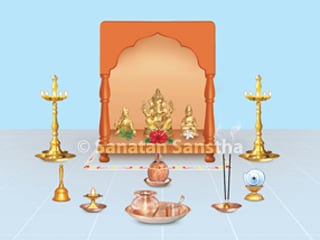
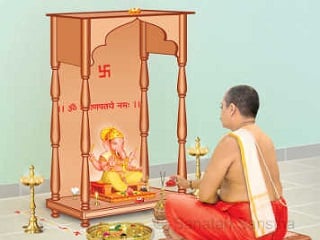 How to perform Puja Vidhi ?
How to perform Puja Vidhi ? Importance of Puja Samagri in ritualistic worship
Importance of Puja Samagri in ritualistic worship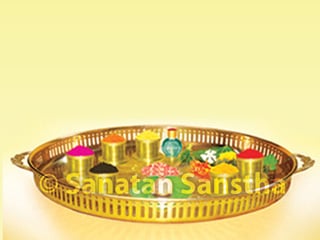 How to arrange the substances in Puja Thali ?
How to arrange the substances in Puja Thali ?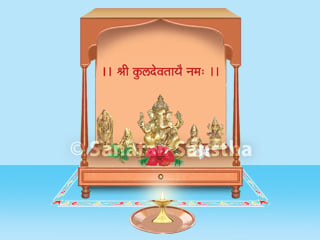 How should be the design of Devghar ?
How should be the design of Devghar ?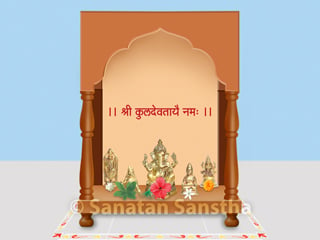 How to arrange Deities in Home temple ?
How to arrange Deities in Home temple ?
Pictorial description of all 16 mudras are required to be displayed for the benefit of the interested persons
What’s the uses of rice grains which we uses over kalash to placed goddess Laxmi on Deepawali